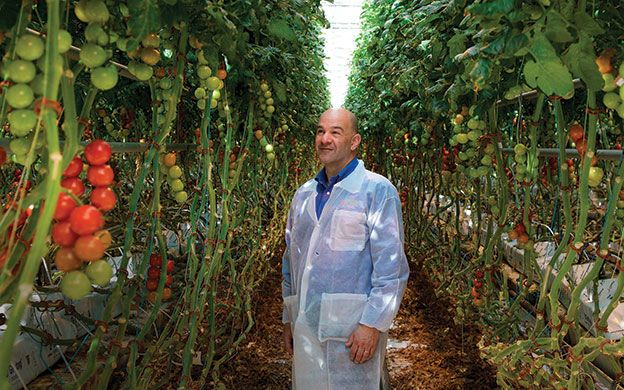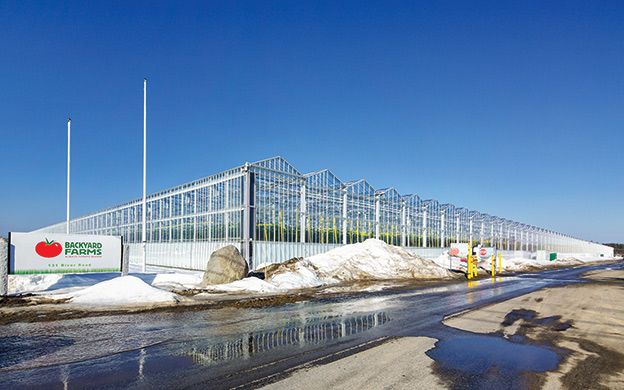'Ripeness is all' as Backyard Farms marks 10th anniversary
Hydroponic tomato grower Backyard Farms celebrated its 10th year anniversary this February on the day its first shipment went out to its first and still largest customer, Hannaford.
The Madison-based tomato grower has come a long way since 2007. It's producing 30 million pounds of cocktail, beefsteak and tomatoes on the vine in two adjoining greenhouses totaling 42 acres. It is the largest building in Maine, says sales director Duncan McSweeney.
By the end of its first year, in December 2007, it already was producing and shipping 17 million pounds of tomatoes from a 24-acre greenhouse, about a third of which were sold in Maine and the rest within same-day picking and shipping in the Northeast. The second greenhouse opened in September 2009, giving it 42 acres of total growing space and 175 employees. There's lots of demand for vine-ripened tomatoes, especially in the harsh Northeast winters when many tomatoes are shipped green and turn an anemic orange by the time they reach store shelves.
But times weren't always so rosy for Backyard Farms. In July 2013, a whitefly infestation forced the company to destroy all of its 420,000 tomato plants and start over. The clean-out of both of its greenhouses delayed deliveries to some 30 retailers across New England, including Hannaford, Shaw's, Roche Bros., Walmart, Wilson Farm and Whole Foods, for up to 10 weeks.
By the following month, the company deemed the new starter plants for a second crop to be inferior and had to find a new supplier. All but essential personnel were furloughed after Labor Day and then hired back as needed. By October the two greenhouses were up and operational. And by December 2013, all employees were rehired and the company began shipping its new crop to stores.
It was a difficult time. But the company made a strong comeback, says Stuart Jablon, who joined Backyard Farms in June 2014 as president and chief operating officer after spending 20 years at Dole Food Co.
“We came back from it and are profitable now,” he says. “At any one point we have about 11 million tomatoes in various stages of development.” About 350,000 to 500,000 pounds of tomatoes are shipped weekly.
The 30 million pounds shipped per year translates into 90 million individual tomatoes. About 60% of those are clustered tomatoes on the vine, 15% to 20% are cocktails sold in small boxes and the rest are beefsteaks. The company also sells the so-called “ugly” or slightly deformed fruit that still is good to eat or use for cooking. About 92% to 95% of the tomatoes are salable as is, while the ugly fruit or what Jablon calls “whoppers” amount to about 450,000 pounds or so a year.
That's a lot of poundage for produce that can bruise and requires delicate handling. “It's difficult, but it's really rewarding, because you work with something living every day,” says Brady Sinclair, who was recently promoted to assistant grower and has been at the company eight-and-one-half years.
Adds marketing director Jim Darroch, “There's such an emotional connection to tomatoes by customers. Everyone can remember picking a warm one in their back yard as a kid and having the seeds squirt out as they ate it.”
Magic on the vine
On a recent visit, we donned paper lab coats and booties before walking into the greenhouse to protect the plants from anything we might shed.
We walk into the first greenhouse. It's warm and humid and smells alive, with growlights brightening the natural light and illuminating plants growing on either side of the center aisle as far as the eye can see.
The plants differ in several ways from those planted in soil. They are on waist-high trays, and each is planted on a “rockroll” to anchor it, then is put onto a long plank of rockwool filled with water and nutrients. The plants are grown at a starter facility elsewhere until they are abut two feet high, then brought into the greenhouse, explains head grower Tony Stevens. They take one week to flower and are ready to pick in eight to 10 weeks.
The trays extend from the center aisle to the end of the greenhouse on each side. A rail down the middle of each row helps the workers use carts to prune, trim and pick ripe tomatoes. The rails also serve as a heat source. Each worker tends five rows of tomatoes on each side, which easily is day-long, hard work, as the tomatoes also extend from the trays up more than eight feet toward the growlights.
The starter plants are brushed with a substance to attract the bumblebees that live in boxes between the rows of plants. The bees pollinate the plants so the tomato-growing cycle can begin.
The tomato vines are trained to grow horizontally, looking more like thick grape vines extending 25 feet long than like typical vertical garden tomato vines. The vines are shaped into parallel rows growing toward a high ceiling and clipped to wires, so the tomatoes can get enough light. The plants grow about one foot weekly, so the growers must make sure to clip leafs below the lowest level of tomatoes so they don't suck nutrients from the plant.
“They need a certain amount of light per day,” says Jablon. December requires more growlight help than the longer natural light during the summer. It's an energy-intensive process. “Our light bill in the winter is $3,000 an hour,” he adds.
The company is experimenting with LED lighting across the tops and mid-sections of the plants to save energy. So far, they've seen more growth as a result as well, as the lower parts of the plants are getting more light.
Growing hydroponic tomatoes is an expensive venture. Adhering to Good Seed Practice Protocols is very expensive, Jablon says, and starting a hydroponic operation, including plants, greenhouses and equipment, costs about $1.5 million per acre, he estimates. Energy is the largest expense, followed by labor.
Liza Graham, director of crop care, who has been with the company almost 10 years, says everything is done by hand, except for the price-code stamps put onto the tomatoes when they are packaged. “I like that I'm working with them from start to finish,” she says of the tomatoes.
The only automated part of the factory is a Canadian-made machine that snaps an image of each box of tomatoes going through it on a conveyor belt to indicate their location. In the next step, a series of arms that place stickers on each fruit recalibrates to the proper position for the box of tomatoes about to pass below it.
The tomatoes are then eyed by an inspection person and the box moves along to be shipped. The tomatoes are picked, packaged and shipped in the same day, head grower Stevens notes, to maintain their freshness. “They're picked red so the sugars last,” he says.
Perks of the job
Each day Graham, Sinclair and other crop care workers slide down the rails in their plant area, which is marked with their name. On this particular visit, crop care worker Mike Towle was clipping some of the larger leafs from the tops of the plants to assure light can get through to the bottom. Looking down the long row he had yet to trim, it looked like a busy day.
Crop care workers are on shift from 6 a.m. to 2:30 p.m. Each can take home five pounds of tomatoes every other week, says Jablon.
The company also offers classes for its employees two nights a week in what it calls the Backyard Farms University in conjunction with the Kennebec Valley Community College. Courses include financial management and other aspects of the company's business.
“It helps us with retention and gives the employees skills,” Jablon says. “This is hard, repetitive work.”
It also sets a path for the future. Jablon, who says the company has under $100 million in revenue, is trying new varieties of tomatoes, including heirlooms, which carry higher margins.













Comments